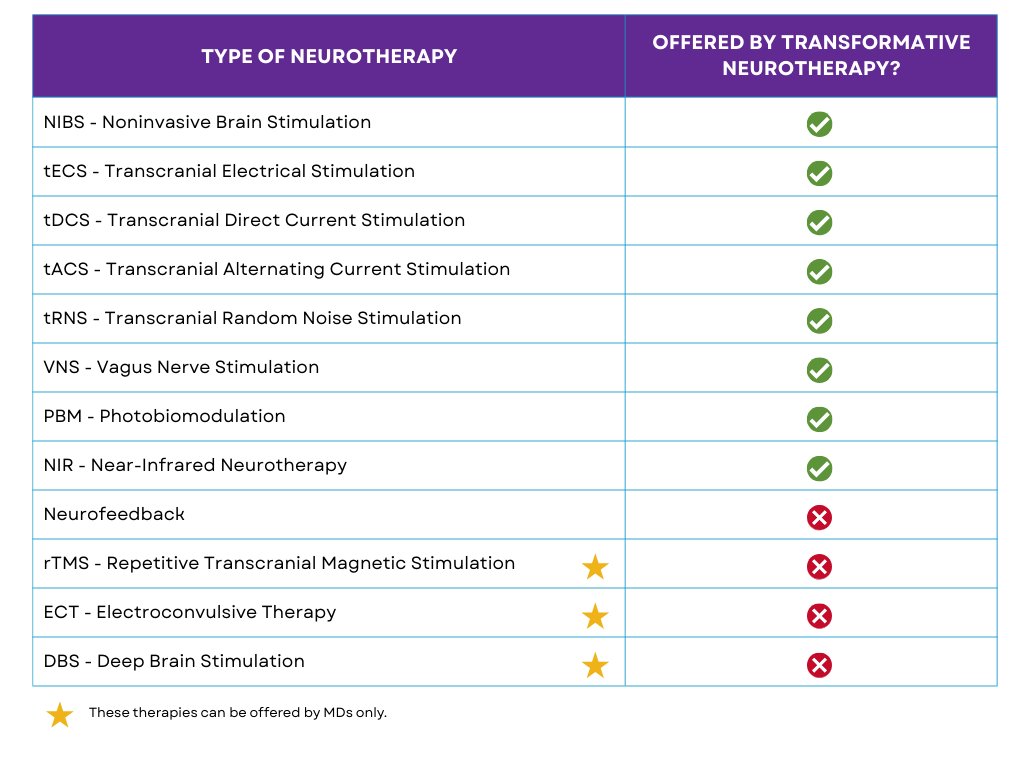NEUROTHERAPY FOR AGING WELL: RESEARCH
Neuromodulation can help with cognitive decline, dementia, and Alzheimer’s disease by stimulating brain activity, enhancing neuroplasticity, and improving blood flow to critical brain regions. Since these conditions are linked to neuronal degeneration, impaired communication between brain cells, and reduced neurochemical function, neuromodulation can help slow disease progression and improve cognitive function. While neuromodulation is not a cure for Alzheimer’s or dementia, it can significantly improve quality of life and slow cognitive decline when combined with lifestyle interventions.
NEUROSTIMULATION (tECS, tDCs, tACs, tRNs, & VNS)
Benussi, A., Cantoni, V., Cotelli, M. S., Cotelli, M., Brattini, C., Datta, A., Thomas, C., Santarnecchi, E., Pascual-Leone, A., & Borroni, B. (2021). Exposure to gamma tACS in Alzheimer’s disease: A randomized, double-blind, sham-controlled, crossover, pilot study. Brain Stimulation, 14(3), 531–540. https://doi.org/10.1016/j.brs.2021.03.007
Benussi, A., Cantoni, V., Grassi, M., Brechet, L., Michel, C. M., Datta, A., Thomas, C., Gazzina, S., Cotelli, M. S., Bianchi, M., Premi, E., Gadola, Y., Cotelli, M., Pengo, M., Perrone, F., Scolaro, M., Archetti, S., Solje, E., Padovani, A., … Borroni, B. (2022). Increasing Brain Gamma Activity Improves Episodic Memory and Restores Cholinergic Dysfunction in Alzheimer's Disease. Annals of Neurology, 92(2), 322–334. https://doi.org/10.1002/ana.26411
Bréchet, L., Michel, C. M., Schacter, D. L., & Pascual-Leone, A. (2021). Improving autobiographical memory in Alzheimer’s disease by transcranial alternating current stimulation. Current Opinion in Behavioral Sciences, 40, 64–71. https://doi.org/10.1016/j.cobeha.2021.01.003
Gangemi, A., Colombo, B. & Fabio, R.A. Effects of short- and long-term neurostimulation (tDCS) on Alzheimer’s disease patients: two randomized studies. Aging Clin Exp Res 33, 383–390 (2021). https://doi.org/10.1007/s40520-020-01546-8
Kim, J., Kim, H., Jeong, H., Roh, D., & Kim, D. H. (2021). tACS as a promising therapeutic option for improving cognitive function in mild cognitive impairment: A direct comparison between tACS and tDCS. Journal of Psychiatric Research, 141, 248-256. https://doi.org/10.1016/j.jpsychires.2021.07.012
Luo, G., Zhang, J., Song, Z., Wang, Y., Wang, X., Qu, H., Wang, F., Liu, C., & Gao, F. (2023). Effectiveness of non-pharmacological therapies on cognitive function in patients with dementia—A network meta-analysis of randomized controlled trials. Frontiers in Aging Neuroscience, 15. https://doi.org/10.3389/fnagi.2023.1131744
Saxena V, Pal A. Role of Transcranial Direct Current Stimulation in the Management of Alzheimer's Disease: A Meta-analysis of Effects, Adherence and Adverse Effects. Clin Psychopharmacol Neurosci. 2021 Nov 30;19(4):589-599. doi: 10.9758/cpn.2021.19.4.589 PMID: 34690114; PMCID: PMC8553534.
Smirni D, Oliveri M, Misuraca E, et al. Verbal Fluency in Mild Alzheimer’s Disease: Transcranial Direct Current Stimulation over the Dorsolateral Prefrontal Cortex. Journal of Alzheimer’s Disease. 2021;81(3):1273-1283. doi:10.3233/JAD-210003
Sprugnoli, G., Munsch, F., Cappon, D. et al. Impact of multisession 40Hz tACS on hippocampal perfusion in patients with Alzheimer’s disease. Alz Res Therapy 13, 203 (2021). https://doi.org/10.1186/s13195-021-00922-4
Romanella, S. M., Roe, D., Paciorek, R., Cappon, D., Ruffini, G., Menardi, A., Rossi, A., Rossi, S., & Santarnecchi, E. (2020). Sleep, Noninvasive Brain Stimulation, and the Aging Brain: Challenges and Opportunities. Ageing Research Reviews, 61, 101067. https://doi.org/10.1016/j.arr.2020.101067
Varastegan, S., Kazemi, R., Rostami, R. et al. Remember NIBS? tACS improves memory performance in elders with subjective memory complaints. GeroScience 45, 851–869 (2023). https://doi.org/10.1007/s11357-022-00677-2
PHOTOBIOMODULATION (PBM)
Enengl J, Hamblin MR, Dungel P, Peter J. Photobiomodulation for Alzheimer’s Disease: Translating Basic Research to Clinical Application. Journal of Alzheimer’s Disease. 2020;75(4):1073-1082. doi:10.3233/JAD-191210
Valverde A, Mitrofanis J. Photobiomodulation for Hypertension and Alzheimer’s Disease. Journal of Alzheimer’s Disease. 2022;90(3):1045-1055. doi:10.3233/JAD-220632
Zhao X, Du W, Jiang J, Han Y. Brain Photobiomodulation Improves Sleep Quality in Subjective Cognitive Decline: A Randomized, Sham-Controlled Study. J Alzheimers Dis. 2022;87(4):1581-1589. doi: 10.3233/JAD-215715. PMID: 35491787.
What Neurotherapy treatments does Transformative Neurotherapy offer?
“Neurotherapy” or “Neuromodulation” is a broad term for a number of different types of treatment options. We’ve outlined below what Transformative Neurotherapy does and does not currently offer.


